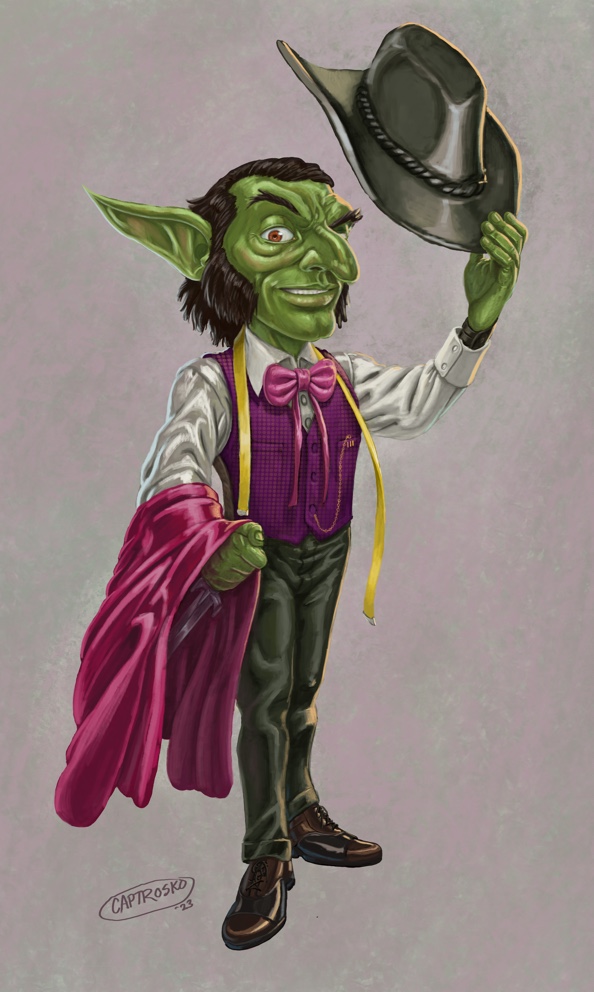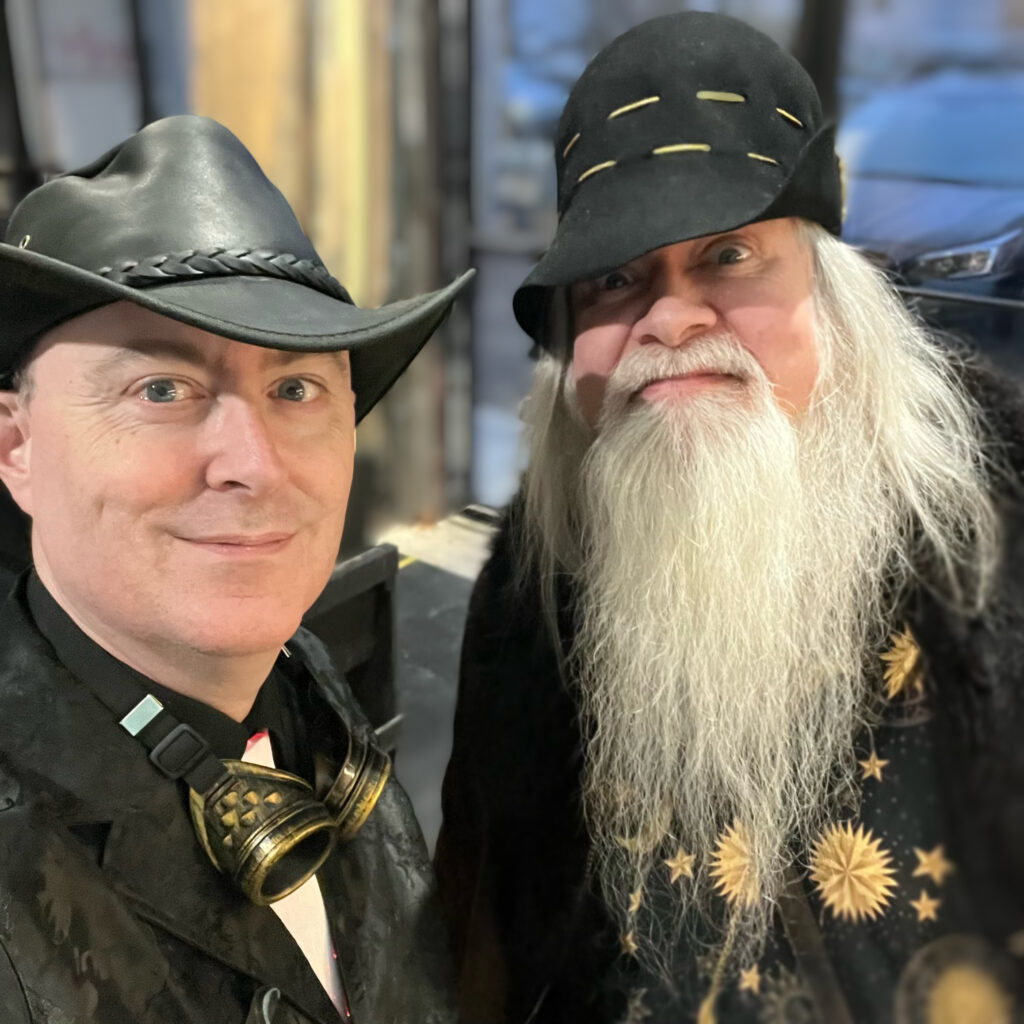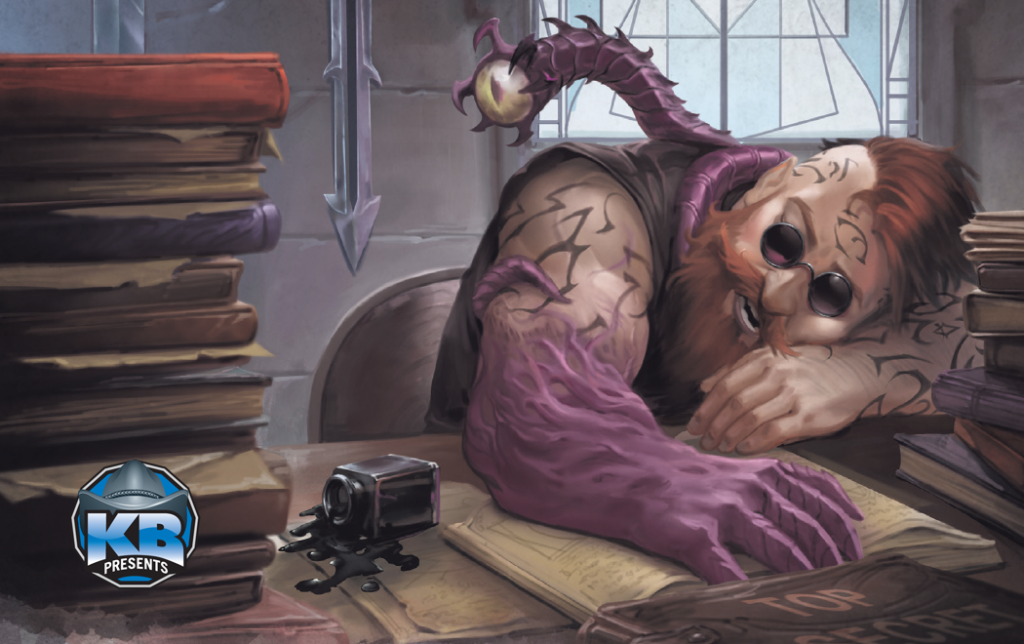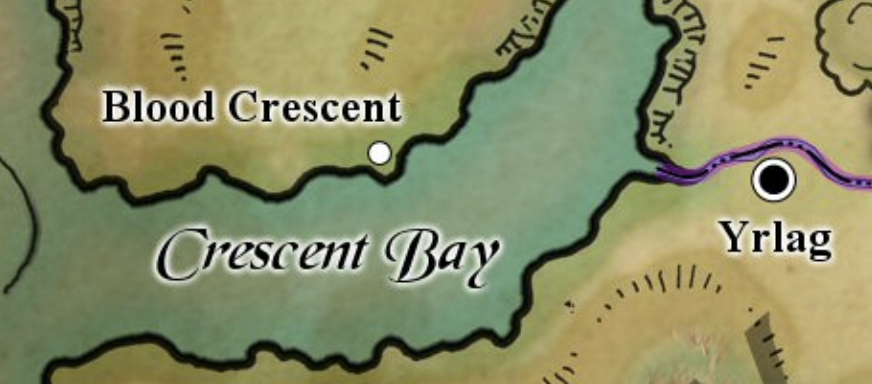
When time allows, I like to answer interesting questions posed by my Patreon supporters. Questions like…
Now that Goliaths are coming to the PHB with their different forms based on their giant ancestry, do you have any thoughts on how they could be included more commonly than the few paragraphs afforded in Chronicles?
Good question. When the Fourth Edition of D&D added Dragonborn and Eladrin to the Player’s Handbook, we found ways to give each of those species roles in the setting that could easily support player characters—while at the same time, not making dramatic changes that would feel jarring to people in long-term Eberron campaigns, such as saying the people of Thrane are all dragonborn. With this in mind we placed a Dragonborn culture in Q’barra, with the idea that the human colonists hadn’t fully differentiated between the Trothlorsvek dragonborn and the Lizardfolk Cold Sun Federation—we’d always said there’d been reptilian humanoids in Q’barra, it just turns out there was a greater variety than people knew about.
In previous sources I’d suggested that Goliath mechanics could be used the represent the Eneko of Sarlona, an offshoot ogre species largely found in the Syrkarn region. This idea—reskinning Goliaths as an existing species—is still an option. Goliaths with fire giant ancestry could be used as Eneko. Goliaths with hill giant ancestry could be reskinned as ogres from Droaam. Cloud giant goliaths could be recast as Oni. That could work. But with them as a core species in the new PHB, it feels weak to me; it’s valid for people to want a place for Goliaths, something more than just “They’re actually ogres.”
Thinking it over, I’ve come up with not one, not two, but FOUR possible options that could work—each with a very different footprint within the setting and a very different set of roles for player characters. The question is how big a role you want goliaths to play and whether you want them to have a dramatic, active story or if you just want a safe space where they can come from. So, here’s a few ideas to consider.
HOUSE VADALIS: PROJECT GOLIATH
During the final decade of the Last War, the Feral Heart of House Vadalis set up a secret facility in Xen’drik. Far from the eyes of the Five Nations, dragonmarked magebreeders used the abhorrent techniques of the Seryan line to imbue human test subjects with the essence of dead giants. These experiments were agonizing and deadly. The test subjects were criminals, deserters, and others smuggled from Khorvaire. Dozens were slain in the initial trials, but over time the research bore fruit, creating few dozen people each carrying a fraction of a giant’s might. It was then that Project Goliath came under attack. The survivors don’t know who was responsible. Was it Sulatar Drow? The Battalion of the Basalt Towers? The Guardians of Rusheme? Whoever was responsible, the disruption allowed the goliaths to break free from their captivity, destroy the facility from within, and escape.
This idea is what I call a small batch approach. The point would be that there’s only around 24 goliaths in the world, and that if you’re a goliath, you know all the others; you were all tormented in that secret Vadalis facility, and all escaped together. You don’t have a large footprint in the world and most people who meet you will have no idea what you are or what you can do. A few key elements of the story…
- Project Goliath was a rogue operation run by the Feral Heart. So House Vadalis as a whole isn’t hunting you down. But member of the Feral Heart may have survived the destruction of the facility. Will you investigate and try to track down any survivors? Or wait and see if they rebuild and come after you?
- How did the Feral Heart capture you? Did they kidnap you directly? Or were you betrayed by someone else? Were you a soldier whose corrupt commander claimed you were a casualty of war before shipping you to Vadalis? A criminal betrayed by your employer? The key point being, are you just happy to be alive, or are you looking for some payback?
- What’s your relationship with the other goliaths? Are you allies trying to help one another and fighting against common enemies? Or… are some of the other goliaths terrible people the world was better off without? Do you feel an obligation to track down these other goliaths before they can wreak havoc in the Five Nations?
- What’s your relationship with the giant who’s essence you carry? Are they fully dead and gone? Are you haunted by their spirit? Or do you perhaps have flashes of their memories, glimpses of artifacts and secrets in Xen’drik that could change the world? And if so, are the other goliaths allies who could work with you to uncover these secrets—or do you need to make sure that no one finds the artifacts you see in your giant-touched dreams?
The point of Project Goliath is that it is a clear and easy path for goliath ADVENTURERS, but it doesn’t actually create a goliath CULTURE. Instead it ties the goliaths directly to the giants of Xen’drik, with that idea that adventurers (and possibly, villainous rivals) going follow dreams and memories to uncover deadly secrets in Xen’drik.
LORGHALEN: ELEMENTAL GOLIATHS
Chronicles of Eberron explores the island of Lorghalen, one of the southern isles of the Lhazaar Principality. The island of Lorghalen and the waters around it are a nexus for powerful elemental energies. As depicted in Chronicles, Lorghalen is home to a gnome culture; but the gnomes are depicted as working closely with native elementals. But a generation after the gnomes settled on Lorghalen, the first goliaths appeared—born fully formed in Lorghalen groves, but with the minds of children. The Lorghalen sages believe that it’s the elemental forces of Lorghalen instinctively responding to the presence of the humanoid settlers—creating these giants to work with the tiny newcomers and to protect them. As such goliaths have always been celebrated in Lorghalen; a newborn Goliath is adopted into a gnome family as a “big brother.”
Lorghalen goliaths feel a deep connection to the natural world. The older they grow the stronger this becomes, and as they grow older they begin to grow in size and elemental power. These Elders have the statistics of giants, but have the Elemental creature type rather than Giant. They are tied to the elemental energies of Lorghalen and rarely leave the island; they dwell in its strongest manifest zones, mediating on the flow of energies and advising Lorghalen stonespeakers.
Lorghalen goliaths are a half-step further than Project Goliath. They have a small footprint in the world and their culture is intertwined with the Lorghalen gnomes. Part of what’s interesting about the Lorghalen goliaths is to play up their elemental connection—they aren’t tied to giants, they’re tied to EBERRON and to the forces of nature. The idea that they are essentially immortal—seeds that will grow into giant elders—can also be a fun thing to explore. As a goliath adventurer, this is your time to see the world before you settled down and become an elder bound to a place of power. You might be a seed cast on the wind looking for a new elemental stronghold out in the world—you could be very interested in meeting druids or other primal cultures. However, this idea of an elemental culture closely tied to gnomes may not be what people want from goliaths. So…
LHAZAAR: THE STONEHEART PRINCIPALITY
Long before humanity came to Khorvaire, a massive airship crashed on the eastern coastline. The ship was built by giants—a unique vessel designed to explore the world beyond the land of Xen’drik. The ship fell because it entered a powerful Lamannian manifest zone, releasing bound elementals and causing the ship to plummet into what is now known as the Forsaken Forest. The wood possesses the Primordial Matter trait of Lamannia, and its vegetation is strong and vibrant—and refuses to be conquered by civilization. The survivors of the crash built a settlement in the woods, but despite their valiant struggles the forces of nature overcame the giant pioneers. Ruins are scattered around the ancient ship, overgrown and worn down. Planar scholars might note the resemblance to the layer called Titan’s Folly in Lamannia—another place where giants fought the power of Lamannia and lost. But this expedition left a lasting mark on the region: Goliaths. When Lhazaar landed in the region that bears her name, she found being already dwelling on the mainland—orc, dwarves, and the mighty goliaths that lived on the edge of the Forsaken Forest. Lhazaar and her peers were ruthless and determined to carve out a home in this new land, and in the days ahead they would slaughter and oppress goblins and other denizens of Khorvaire. But the Goliaths of Skairn were too strong and too well entrenched to be easily conquered. The newcomers established treaties with the giantfolk, establishing what is now known as the Stoneheart Principality. The Stoneheart capital of Skairn plays an important role in the Principalities. The goliaths have little interest in seafaring and take to the water only to fish; but the Lamannian-touched lumber they harvest from the Forsaken Forest is some of the finest available in the region, and traders come from across the Principalities to purchase lumber for their shipwrights. The Stoneheart don’t have a fleet on the water, and Skairn remains neutral in the feuds of the Sea Princes; it is a friendly port for all.
The Stoneheart Goliaths are proud of their ancient ties to the land. They believe they are descended from the ancient giants that fell in the forest, and that they have ties to the region older even than those of the dwarves. Mechanically, there is one important element. Goliaths are born with the Powerful Build trait—they are large and powerful. But upon reaching adolescence, they make a pilgrimage into the Forsaken Forest, traveling to the ancient shipwreck and touching an artifact within it: a massive stone charged with mystical energy, which they call The Stone Heart. Touching the stone sends a surge of mystical energy through the young goliath, triggering their Giant Ancestry trait (and providing access to Large Form, though not all goliaths manifest this power). one aspect of this is that the Giant Ancestry trait isn’t directly hereditary; the child of two goliaths with fire giant ancestry could manifest Stone’s Endurance or Storm’s Thunder. There are also goliaths in other principalities—notably, the Cloudreavers—who don’t possess Giant Ancestry, as they have never been to the Stone Heart to activate this latent power.
The Stoneheart Principality is prosperous, buoyed by the lumber trade and the strength of its people. Stoneheart goliaths have never sent a fleet onto the water, but they have often served as mercenaries for other princes. A small number of elite Stoneheart mercenaries sell their services through House Deneith, and the princes of Karrnath have traditionally had a goliath bodyguard. As such, while goliaths are rarely seen in the Five Nations, they are recognized and renowned for their strength, endurance, and commitment to a task. During the Last War, Deneith brokered the services of an elite company of goliaths known as the Stone Hammer. Throughout most of the war they served Karrnath; but toward the end of the war Cyre lured them away. Because of this, most members of the Stone Hammer died in the Mourning. Many of the survivors have chosen to remain with communities of Cyran refugees, holding to their last contract to protect Cyre. The former captain of the Stone Hammer, Skuldaran, now protects Prince Oargev in New Cyre.
The point of the Stoneheart Principality is to give the goliaths of Khorvaire a unique culture, role in history, and tie to the giants of Xen’drik without having such an overwhelming presence that it feels strange not to have encountered them before. People across the Five Nations have heard of goliaths due to royal bodyguards and the tone Hammer, but they are still quite rare outside the Lhazaar Principalities. Within the Principalities they have an important role, but they are a mainland force that has no strong ties to piracy. They were there before Lhazaar, and they are the people of wood and the stones of the coast. They have no interest in sailing on the water, but it is their lumber that makes it possible. And this is also a way to add flavor to the canonically undeveloped port of Skairn and the Forsaken Forest. What is the Stone Heart, and what other secrets could be hidden in the ancient ruins around it?
THE GOLATHARI: THE TITAN’S BLADE
In the last days of Xen’drik, the immortal titan Golath foresaw the plans of the dragons and led a small force into a Khyber demiplane. Golath was a target of interest, and he sealed the gate to the plane behind him so that the dragons would find no trace of him and believe him dead. Golath and his kin conquered the native denizens of the demiplane, and over the course of tens of thousands of years they built a mighty empire. Now they have returned… and they want vengeance.
The idea of the Golathari is to take many of the traditional tropes of the Githyanki and recast them onto Goliaths. They are a brutal, powerful extraplanar raider culture ruled by a godlike immortal tyrant. Goliaths are descended from the giants who accompanied the titan Golath and the humanoid natives of the demiplane; over the course of tens of thousands of years they have become a unique species. Unlike what I’ve suggested for the goliaths of the Stoneheart Principality, the Giant Ancestry of the Golathari goliaths would be hereditary, and furthermore, this is where I’d use the Ordning.The giants of ancient Xen’drik didn’t have this tradition, but it is something established by Golath and maintain among his goliaths as well as the actual giants of his demiplane; goliaths with hill giant ancestry are expected to show respect to those further up the Ordning.
The idea of the Golathari is that they are a brutal martial culture that has held onto and built upon some of the mystical traditions of Xen’drik, as well as working with unique materials and energies found in their demiplane. For millennia, Golath has been plotting a way to take revenge against Argonnessen, and he is finally putting that plan into action. He has found a way to open portals from his demiplane into Eberron, but it is currently impossible for anyone to enter the demiplane against his wishes. He has developed weapons uniquely suited to fighting dragons. Dragonbane weapons are an easy option, but this could also be the source of Orbs of Dragonkind. I could also imagine him having developed artifacts that can temporarily strip a dragon of its inherent arcane abilities. If you wanted to borrow a further twist from the traditional Githyanki story, Golath could have forged a dangerous alliance with the Daughter of Khyber—who is content for Golath to slay and enslave dragons and break the current civilization of Argonnessen knowing that when she herself is freed her children will destroy the last titan. But for now Golath’s weapons—like Orbs of Dragonkind—could be empowered by the overlord, and he could Spawn of Tiamat fighting alongside his goliaths.
If I used this story, I would make the Golathari Incursion something that’s unfolding RIGHT NOW. Across the world, Golathari raiders are striking Chamber operations and assassinating rogue dragons. They may be gathering parts for a devastating weapon that could strip the arcane power of all the dragons of Argonnessen. The Golathari goliaths believe in their righteous cause and are utterly devoted to their immortal tyrant; again, this is a space where you could borrow the relationship between the Githyanki and Vlaakith in other settings. And with that in mind, that’s a key element for Golathari goliath adventurers: are you a loyal servant of the Titan King on an important mission requiring you to work with these tiny denizens of this backwater world? Or are you a rebel and a renegade, someone who knows that Golath consumes the essence of those goliaths who become too powerful, and who sees him for the tyrant he is?
EVERYDAY GOLIATHS
The four ideas presented above are all designed to give goliaths a STORY within the world—whether it’s a very recent story like Project Goliath, or if they’ve been around for a while, like the Stoneheart Principality. However, you don’t HAVE to give goliaths a deep story. And even if you DO use the Stoneheart Principality, you can make a goliath who’s just descended from a family of goliaths that immigrated to Karrnath centuries ago and think of themselves as Karrns. Just as Brelish dwarves and elves are BRELISH rather than having ties to the Mror or Aereni cultures, if you just want to play a goliath from Sharn who works for the Boromars and doesn’t CARE where he came from, that’s fine. Likewise, I said above that I wouldn’t turn the entire population of Thrane into dragonborn… but I have no problem with the idea that there may be dragonborn living in Thrane. Someone raised the idea that it would be cool to have a community of wyvernborn living in Thrane, and I love that; I just wouldn’t completely change the established culture and history of Thrane in adding them. But as long as player and DM are on the same page, you don’t have to use a story that’s as exotic as any of these options to add a new ancestry to your campaign.
IN CONCLUSION…
While these ideas aren’t mutually exclusive, I personally would choose one of them for my campaign. Project Goliath is the least intrusive, as only a handful exist. The Lorghalen goliaths have a very small footprint; they have a place to call home, but haven’t made much impact. The Stoneheart Principality is a way to give goliaths a clear and unique culture while still interweaving them with the existing story of the Lhazaar Principalities. And the Golathari are both an active and entirely new threat, rising up from Khyber with an aggressive agenda. And if they CAN actually strip Argonnessen of its power, what will that do to the balance of power in the world? Who will stand against the Lords of Dust?
Feel free to discuss these ideas in the comments, but I am unlikely to have time to answer questions here. If you do want to ask me questions — like the one that inspired this article! — check out my Patreon.





